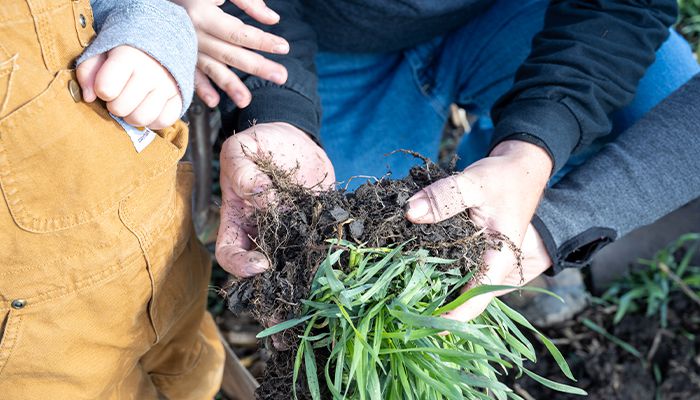Leaving the land better for future generations
Author
Published
4/1/2024
Mahaska County Farm Bureau member utilizes cover crops and other conservation practices to enhance sustainability.
Jackson Drost applies the Golden Rule on his Mahaska County farm, treating every acre as if it were his own. The principle extends to communication with landowners and farm managers, who Drost works to keep informed through weekly updates.
His philosophy stems from a Bible verse, Matthew 7:12 – “Do unto others as you would have them do unto you.”
“I look at that — whether it’s people we rent ground from, people we custom farm with — I like to think if I was them, how would I want to be communicated to? How would I want to be treated?” says Drost, a Mahaska County Farm Bureau member. “That’s how I hope for us to be seen (and) be known.”
Drost’s conservation and outreach efforts led to his recognition as Peoples Company’s 2023 Farmer of the Year.
“Peoples Company’s Farmer of the Year award goes to an individual with integrity, honesty; a farmer that produces well and does things the right way with sustainability and conservation,” said Kyle Walker, Peoples Company director of land management.
Walker manages the Blanche Johnson Trust Farm, rented by Drost and his family. The farm trustee is MidWestOne Bank, and the beneficiary is William Penn University.
Since he began renting the Johnson farm, Drost and his family have worked to integrate conservation practices and make general improvements to the land. He provides weekly updates to Walker regarding farm activities, and the two discuss upcoming plans.
“Jackson has implemented a lot of cover crops. If you look out at this farm we’re standing on, we have oats and radishes. They look phenomenal,” Walker says. “We’re doing a lot of improvements with the waterways, cleaning up fence rows, tiling work, the terrace project. These farms have just really transformed over the last five years.
“We get a lot of calls saying the farm looks better than it did five years ago. And that means a lot to me.”
Important partnerships
Partnerships between farmers and landowners/farm managers are critical in achieving the goals of Iowa’s water quality initiative.
An Iowa State University study conducted in 2022 indicated that 58% of Iowa’s farmland, or about 17.6 million acres, was rented or leased, up from 53% (16.7 million acres) five years earlier.
Farmers must be willing to innovate and try new practices and solutions to make their farm successful for future generations, Drost says. The way his grandfather farmed decades ago wouldn’t be successful today, he says.
“We have to be sustainable for years to come,” says Drost, who farms with his dad and uncle. “I want it to be there for my sons if they choose to farm.”
Farming was ingrained in Drost’s personality at a young age.
“I say I started farming the day I was born,” he says. “My dad carried his diaper bag with him when I was with him.”
Now Drost is passing the lessons learned on the farm forward, involving his two sons, 9-year-old Richard and 3-year-old Andy, as much as possible.
“Farming is a lifestyle for us,” says Amanda Drost, Jackson’s wife. “It’s just wonderful to be able to work alongside each other — bringing the boys with us to the field or just working cattle — to do everything together as a family.”
Cover crop tips
The Drosts raise corn, soybeans and alfalfa along with an Angus cow-calf herd. Drost said his row crop rotation is typically two-thirds corn and one-third soybeans. About two-thirds of his acres are seeded with cover crops, primarily rye and oats.
He recommends farmers interested in trying cover crops start small to figure out what works best on their acres.
“You don’t go 100% your first year. Start small, and have somebody talk with you, help you,” he says. “If a person goes 100% from day one and something goes bad or something goes wrong, they’re not going to do it again.
“And their word of mouth about their experience is going to keep somebody else from doing it.”
Drost says he talks daily with his dad and uncle when it comes time to terminate the cover crops and prepare fields for planting in the spring. He uses a spreadsheet to create a detailed work plan for every field, listing the cover crop and every step leading up to cover crop termination.
“I’ve found that management and planning relieves the headache when ‘go time’ happens,” says Drost. “You’ve got to manage it to make it work.”

Picture above: Cover crop roots hold soil together and sequester nutrients. PHOTO / CONRAD SCHMIDT
Want more news on this topic? Farm Bureau members may subscribe for a free email news service, featuring the farm and rural topics that interest them most!